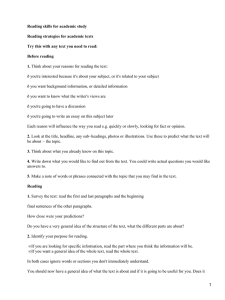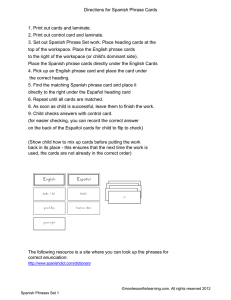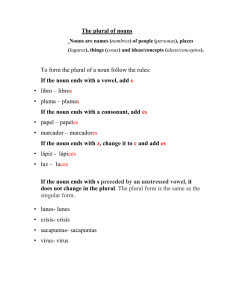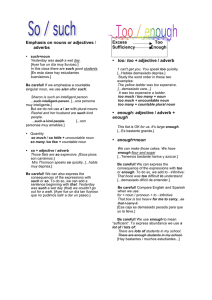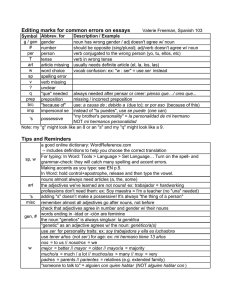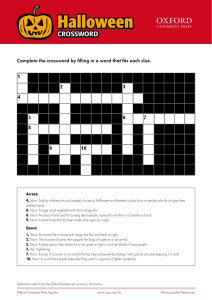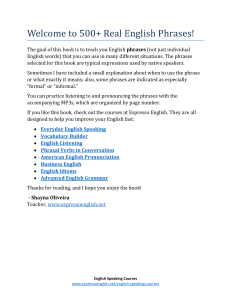UNED at Image CLEF 2004: Detecting Named Entities and Noun
Anuncio
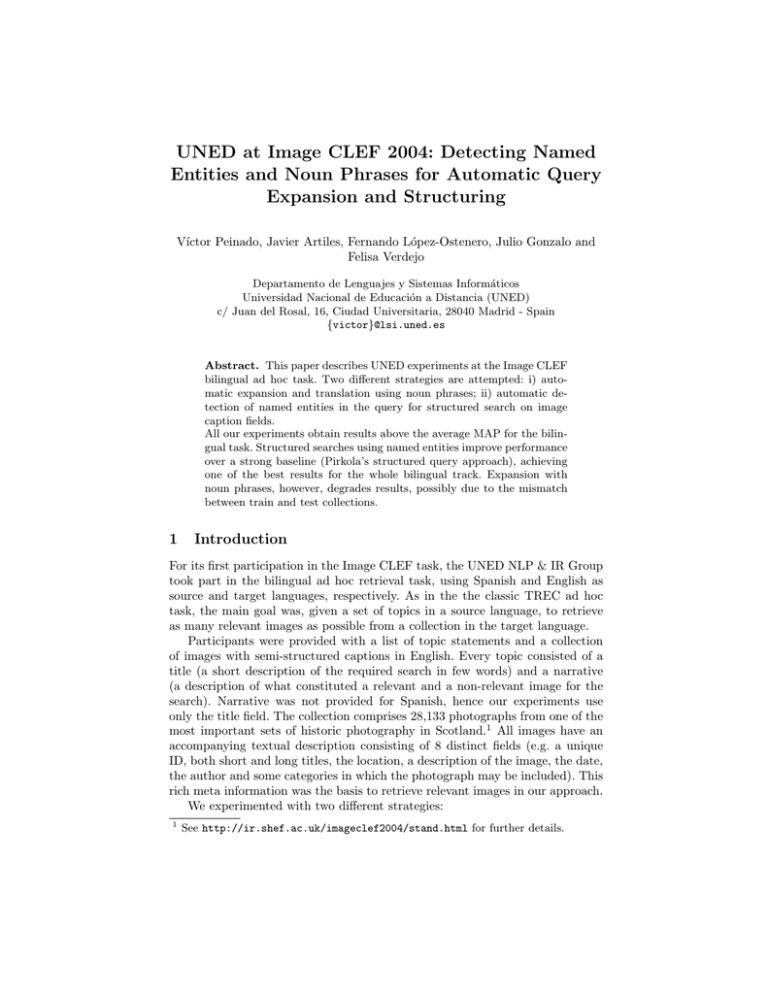
UNED at Image CLEF 2004: Detecting Named
Entities and Noun Phrases for Automatic Query
Expansion and Structuring
Vı́ctor Peinado, Javier Artiles, Fernando López-Ostenero, Julio Gonzalo and
Felisa Verdejo
Departamento de Lenguajes y Sistemas Informáticos
Universidad Nacional de Educación a Distancia (UNED)
c/ Juan del Rosal, 16, Ciudad Universitaria, 28040 Madrid - Spain
{victor}@lsi.uned.es
Abstract. This paper describes UNED experiments at the Image CLEF
bilingual ad hoc task. Two different strategies are attempted: i) automatic expansion and translation using noun phrases; ii) automatic detection of named entities in the query for structured search on image
caption fields.
All our experiments obtain results above the average MAP for the bilingual task. Structured searches using named entities improve performance
over a strong baseline (Pirkola’s structured query approach), achieving
one of the best results for the whole bilingual track. Expansion with
noun phrases, however, degrades results, possibly due to the mismatch
between train and test collections.
1
Introduction
For its first participation in the Image CLEF task, the UNED NLP & IR Group
took part in the bilingual ad hoc retrieval task, using Spanish and English as
source and target languages, respectively. As in the the classic TREC ad hoc
task, the main goal was, given a set of topics in a source language, to retrieve
as many relevant images as possible from a collection in the target language.
Participants were provided with a list of topic statements and a collection
of images with semi-structured captions in English. Every topic consisted of a
title (a short description of the required search in few words) and a narrative
(a description of what constituted a relevant and a non-relevant image for the
search). Narrative was not provided for Spanish, hence our experiments use
only the title field. The collection comprises 28,133 photographs from one of the
most important sets of historic photography in Scotland.1 All images have an
accompanying textual description consisting of 8 distinct fields (e.g. a unique
ID, both short and long titles, the location, a description of the image, the date,
the author and some categories in which the photograph may be included). This
rich meta information was the basis to retrieve relevant images in our approach.
We experimented with two different strategies:
1
See http://ir.shef.ac.uk/imageclef2004/stand.html for further details.
1. Expand queries with noun phrases. Queries are expanded with related noun
phrases, looking up a bilingual Spanish-English noun phrase list which was
extracted from the CLEF news comparable corpus (LA Times 1994, Agencia
EFE 1994).
2. Identify named entities and dates in queries, and perform structured queries
against appropriate image caption fields:
a) Proper names are searched in the “author” and/or “location” fields. If
the search is non-nil, the retrieval mechanism favours images containing
these entities in that fields.
b) Temporal references are searched in the “date” field. If the search is
non-nil, images matching the temporal reference in the date field are
favoured.
Prior to experimenting with these strategies, we first built an improved
English-Spanish translation resource, merging our in-site dictionaries with free
web resources.
Reasons to try the above techniques include:
1. Expansion with Natural Language approaches is more benefitial with short
queries [1] or short documents such as image captions [2]. Being in a CrossLanguage search context, we decided to experiment with our query expansion
technique based on aligned noun phrases, that gave excellent results in the
CLEF interactive track [3–5].
2. Since the ImageCLEF collection contains structured image captions (including author, date, location and description fields) it seems interesting to explore the possibility of detecting different types of information in the query
to perform more precise searches. Then, we experiment with a simple strategy that tries to match every named entity as a possible author name or
location.
This paper is structured as follows: in Section 2, we first discuss the possibilities of using noun phrases in query expansion and interactive tasks, then we
present the linguistic resources used (Section 2.1), our preliminary CLIR experiments on the CLEF collection (Section 2.2) and the settings of our Image CLEF
experiments (Section 2.3). Then, we explain the structured searches approach
(Section 3) and discuss the official results obtained in the track (section 4).
Finally, in Section 5, we draw some conclusions.
2
2.1
Query expansion with noun phrases
Linguistic resources
We used two comparable corpora from the CLEF ad-hoc track: the Spanish
newswire collection EFE 1994, and the Los Angeles Times 1994 news collection.
Out of these comparable corpora, we built a bilingual dictionary containing
more than five million aligned noun phrases2 . Noun phrases are automatically
recognized and extracted using statistical data such as the frequency of sequences
of two or three informative words (nouns and adjectives) in both languages
[6]. We consider that two phrases are aligned if they have the same amount of
informative words and there is a one-to-one correspondence using a bilingual
dictionary (see Table 1 for examples).
English
Spanish
Orange County
Condado de Orange
abortion issue
tema del aborto
free trade agreement acuerdo de libre comercio
World War II
Segunda Guerra Mundial
Table 1. Example aligned phrases using CLEF comparable corpora.
Previous UNED participations in the iCLEF track3 proved the utility of noun
phrases for document selection [3], query translation and refinement ([4, 5]).
Finally, we built a new bilingual Spanish-English dictionary made up from
heterogeneous lexicographic resources such as dictionaries and word lists (some
of them freely available in the Web) and semantic networks such as WordNet
[7] and EuroWordNet [8]. Every source went through a cleaning process before
merging them in an XML-structured dictionary showing up all the information
from each original source, almost without typos or inconsistencies. As a result of
this merging, our final dictionary contains more than 57,000 entries in Spanish
and 85,000 in English, with a total size of about 50 Mb4 .
2.2
Preliminary experiments over the CLEF collection
In order to check the usefulness of noun phrases for Cross-Language ad hoc
retrieval, we have performed a number of experiments with 140 Spanish CLEF
topics (corresponding to 2001-2003 campaigns) and the LA Times 1994 English
CLEF collection. We start with the three following baselines based on word by
word translation using bilingual dictionaries:
naive baseline Word by word translation, building a bag of words with all the
possible translations appearing in our dictionaries.
2
3
4
Roughly, there are more than 4.5 million phrases containing two informative words
and 850,000 containing three.
The Interactive track for the Cross-Language Evaluation Forum webpage is available
at http://nlp.uned.es/iCLEF.
Using this merged dictionary instead of the original VOX dictionary we used in
previous approaches, there is an improvement in CLIR experiments with the CLEF
collection of 36%
frequencies We built a bag of words from only those possible translations appearing in more than one lexicographic source, assuming that they should
be the most common and reliable.
Following this strategy, we pursued two goals: on one hand, we used only
those translations considered reliable. On the other hand, we rejected residuary translations from semantic networks in order to reduce the noise produced by the expansion.
strong baseline We used Pirkola’s proposal [9] to build structured translated
queries, using the synonymy operators implemented in the INQUERY search
engine [10] to wrap alternative translations for every word in the query.
systran The queries were translated using the Systran machine translation system.
These baselines are compared with three runs using the bilingual noun phrase
list:
phrases + pirkola We used our noun phrases dictionary to expand the query
with related noun phrases and translate them using a bilingual dictionary.
Our strategy was the following: firstly, we expanded each topic term with
the ten most frequent noun phrases containing the term in the CLEF collection and then we translated the phrases using the aligned noun phrase
list. Those query terms from which no phrases were identified were included
in the translated query using Pirkola’s approximation, i.e. using synonymy
operators.
“multi-lemma” phrases + pirkola In order to limit the noise produced by
the phrase expansion of the previous experiment, we only use noun phrases
containing at least two query terms.
phrases + pirkola + systran Combined run using all three resources, i.e.
noun phrases, structured translations using our dictionaires and the Systran
machine translation system.
As shown in Table 2, our experimental proposals using noun phrases outperformed the baselines. The differences were statistically significant according
to a non-parametric Wilcoxon sign test. The strong baseline obtained the same
average precision than Systran’s translations, showing that the combination of
Pirkola’s structured query approach with reliable lexicographic resources is an
excellent CLIR baseline.
In summary, our results show that:
– Phrases do improve CLIR results, at least when the training corpus and the
test corpus are similar. Even though the porcentual gain is not very high, in
a setting with very small documents (e.g. image captions or topic titles) it
would be reasonable to expect higher improvements.
– There is no need to use external machine translation systems, at least when
translating small documents.
– The “multi-lemma” variant of noun phrase expansion performs slightly better for batch CLIR, although the difference is not statistically relevant according to a Wilcoxon sign test.
run
Avg. precision
naive baseline
.19
frequencies
.25
strong baseline
.27
systran
.27
phrases + pirkola
.29
phrases + pirkola + systran
.30
‘‘multi-lemma’’ phrases + pirkola
.31
Table 2. Results of our preliminary experiments
– The quality of a translation strongly depends on the resources used.
2.3
Settings for ImageCLEF experiments
Extending the above results to the Image CLEF bilingual ad hoc task, we have
used the corpus and the set of Spanish topics provided by the organization, our
bilingual XML dictionary, the Systran machine translation system5 and the set
of aligned noun phrases between English and Spanish.
Topic titles were processed, stopwords and punctuation removed6 and content
words lemmatized before translation using the merged dictionary or the noun
phrase bilingual list.
Since the image captions contain structured information, we decided to use
it by identifying which query terms could be understood as authors, locations
or dates.
3
Structured search using image caption fields
3.1
Entities Recognizer
We used a set of simple rules to identify named entities, temporal references and
numbers in the queries:
Named entities Expressions in uppercase wherever uppercase is not prescribed
by punctuation rules.
Temporal references Those ones matching words such as names of weekdays,
months or seasons.
Numbers Those ones matching any numerical expression or words from a given
list (e.g. dos (2), cien (100), mil (1,000) . . . )
5
6
Systran web-based interface available at http://www.systransoft.com
In order to adapt the stopword list to this specific task, we included as stopwords
fotografı́as, fotos (photographs), retrato (portrait). . .
3.2
Structured search over image caption fields
For each entity located in the Spanish topic titles:
– If it is a named entity, we ask the search engine to find any document containing the entity in the “author” or “location” fields, first in Spanish and
then in English.7 If the search is non-nil, we assume that the role of the
entity is the field in which it was found.
– If it is a cardinal number, we ask the search engine to find any document
containing the entity in the “date” field. If the search in non-nil, we assume
that the cardinal number represents a date.
– If it is a temporal reference, we check if it is a date, in the same fashion.
3.3
Entities, dates and numbers found in the queries
In Table 3, we show the entities found for each Spanish topic title. Our recognizer
located 31 entities (named entities, temporal references and cardinal numbers),
although some of them are incorrect. For instance, on topic 5 Irlanda and Norte
should have been identified as a unique named entity Irlanda del Norte. Elisabeth,
on topic 14, was not identified as a possible entity. Besides, on topics 11 and
13, expressions such as Postales and Campeonato Abierto were misidentified as
named entities.
Entities such as Postales, Campeonato Abierto, Reina Madre and Segunda
Guerra Mundial did not represent any author, location or date. In any case, our
strategy did not identify them as such either.
Regarding the other located entities, a manual analysis about their roles
showed that:
authors Every possible author (Thomas Rodger, John Fairweather and George
Middlemass Cowie) was correctly identified using this strategy.
locations Roma, Irlanda, Norte, British Columbia, Canadá, Egipto, Londres,
Bute, Escocia and York were correctly identified. St. Andrews, Cambridge,
Tay Bridge, Crail Camp, North Street and Edimburgo were not.
dates Abril, 1908, 1879, 1939, 1954, 1900. All dates were identified with this
strategy.
Overall, the algorithm is reasonably precise, given the very simple heuristic
rules used for detection. But there is still room for improvement using proper
Named Entity Recognizers.
7
We perform the search in both languages because there is no general rule for translating proper names. Entities were translated using Systran because of the lack of
proper names in our dictionary.
topic # Entities
1
Retratos de ministros de la iglesia por [N E Thomas Rodger].
2
Fotos de [N E Roma] que fueron tomadas en [DAT E Abril] de [CARD 1908].
3
Vistas de la catedral de [N E St. Andrews] por [N E John Fairweather].
4
Hombres vestidos militarmente, [N E George Middlemass Cowie].
5
Buques de pesca en [N E Irlanda] del [N E Norte].
6
Vistas panorámicas en [N E British Columbia], [N E Canadá].
7
Vistas exteriores de templos en [N E Egipto].
8
Edificios de la universidad o colegios universitarios, [N E Cambridge].
9
Fotos de faros ingleses.
10
Calles en plena actividad en [N E Londres].
11
Tarjetas [N E Postales] con múltiples vistas de [N E Bute], [N E Escocia].
12
Desastre ferroviario en el [N E Tay Bridge], [CARD 1879].
13
Torneo del [N E Campeonato Abierto] de golf, [N E St. Andrews] [CARD 1939].
14
Elizabeth la [N E Reina Madre], en su visita a [N E Crail Camp], [CARD 1954].
15
Daños provocados por bombas en la [N E Segunda Guerra Mundial].
16
Fotos de la catedral del [N E York].
17
Vistas de [N E North Street], [N E St. Andrews].
18
Fotos del castillo de [N E Edimburgo] antes de [CARD 1900]
19
Gente marchando o desfilando.
20
Rı́o con un viaducto al fondo.
21
Monumentos a los caı́dos en la guerra en forma de cruz.
22
Fotos mostrando tradicionales bailarines escoceses.
23
Fotos de cisnes en un lago.
24
Golfistas golpeando con sus palos de golf.
25
Barcos en un canal.
Table 3. Named entities, temporal references and cardinal numbers located for each
topic title.
4
4.1
Results and discussion
Submitted runs
Given the preliminary results discussed in Section 2.2, we decided to use the
following strategies in our ImageCLEF experiments:
– Naive baseline using a word by word translation (UNEDESBASE). For instance,
topic 13 (Torneo del Campeonato Abierto de Golf, St. Andrews 1939) produces:
topic 13: turn tourney tournament tourney joust tilt championship title
open frank open-minded opened overt unconcealed undone up extrovertish
unfastened unlatched unlocked unsecured exposed hospitable forthright
open-ended unresolved outgoing assailable undefendable undefended unhealed
open undo dig head lead blossom unlock spread unfold brighten clear golf
st andrews 1939
– Strong baseline using a structured query, following Pirkola’s approach (UNEDES).
This is the core of the structured query for the next approaches, using INQUERY’s synonymy operators:
topic 13: #syn( turn tourney ) #syn( tournament tourney joust tilt )
#syn( championship title ) #syn( open frank open-minded opened overt
unconcealed undone up extrovertish unfastened unlatched unlocked
unsecured exposed hospitable forthright open-ended unresolved outgoing
assailable undefendable undefended unhealed ) #syn( open undo dig head
lead blossom unlock spread unfold brighten clear ) golf st andrews 1939
– Structured query using INQUERY’s operators and structured search over
captions (UNEDESENT).
If some entity is located and identified as a possible author name, location or
date, we include the structured search over the caption fields. In this case,
the search engine will favor those images in whose caption fields 1939 is
tagged as a date. So, the following operator is added to the previous query:
#field( DDATE #sum( 1939 ) )
– Structured query using INQUERY’s operators and structured search over
captions + noun phrases (UNEDESENTNOO and UNEDORENTNOO).
We detected several errors in the original Spanish query set. These were fixed
and sent to ImageCLEF organizers for distribution among other participants.
However, for completeness, we submitted the most complex runs both with
the original and the fixed query set (UNEDORENTNOO and UNEDESENTNOO, respectively).
In order to expand the queries, we added the set of noun phrases extrated
from the query terms using the “multi-lemma” phrases strategy. For topic
13 and UNEDESENTNOO, the phrases included are:
#phrase( golf course manager ) #phrase( world golf championship )
#phrase( world championship tournament ) #phrase( first golf tournament
)
#phrase( day after a golf tournament ) #phrase( chiefs into the title )
#phrase( clear the tournament ) #phrase( champions tournament )
#phrase( conference tournament title ) #phrase( day golf tournament )
#phrase( golf tournament last ) #phrase( league golf tournament )
#phrase( tournament of champions ) #phrase( phoenix golf tournament )
#phrase( tennis tournament in st ) #phrase( championship golf course )
#phrase( ups for golf ) #phrase( championships golf tournament )
#phrase( gains after a bond ) #phrase( final of the tournament
of champions ) #phrase( tournament at st ) #phrase( bond gains )
#phrase( title of chief )
Summing up, the set of submitted runs and its features are shown in Table 4.
4.2
Results
All five runs obtained results above the average (average MAP for Spanish as
query language is 0.30). Our best run, UNEDESENT, was the best Spanish →
run
word translation noun phrases structured caption
UNEDESBASE
bag of words
X
X
UNEDES
Pirkola
X
X
√
UNEDESENT
Pirkola
X
√
√
UNEDESENTNOO
Pirkola
√
√
UNEDORENTNOO
Pirkola
Table 4. UNED submitted runs.
English submission, 88% of the best monolingual run and 97% of the best crosslanguage submission (DCU German → English). Our results are shown in Table 5.
Structured queries over image captions (UNEDESENT) obtained an improvement of around 8.3 % with respect to Pirkola’s approach (UNEDES). Apparently,
a very simple detection of entities can be useful to improve retrieval results using
the rich structure of image metadata.
Expansion with noun phrases does not improve over the baseline. The main
reason is that our set of aligned noun phrases had been previously extracted
from a collection of very different genre (newswire). As shown on section 4.1,
the expansion inserted too much noise to get better average results.
Finally, it is worth noticing that our weakest baseline (UNEDESBASE) is about
26% better than the average MAP for the Spanish participants, confirming that
a good bilingual resource is at least as important as the CLIR technique being
used.
run
Best monolingual
Best cross-language
Best ES - EN
UNEDESENT
UNEDES
UNEDESENTNOO
UNEDORENTNOO
UNEDESBASE
average
MAP % monolingual
0.59
0.53
90
0.52
88
0.52
88
0.48
82
0.47
80
0.42
72
0.38
64
0.30
50.87
Table 5. Results for UNED runs.
5
Conclusions
In this paper, we have presented two different strategies applied to the ImageCLEF bilingual ad hoc task:
– Expand queries with noun phrases, translating and expanding the queries
with noun phrases automatically extracted from a different corpus. This expansion degrades retrieval results in our experiments, indicating that techniques based on bilingual comparable corpora can be useless when the training and test domains are very different.
– Perform structured searches using named entities and dates automatically
located in the query. This technique obtains an improvement of 8.3 % with
respect to our baseline (Pirkola’s approach) and can be easily extended to
other searches over structured documents.
In addition, even our simplest baselines have performed above the average,
showing that work on merging bilingual dictionaries can be as important as the
retrieval strategy in CLIR tasks.
Acknowledgements
This work has been partially supported by a grant from the Spanish Government, project R2D2 (TIC2003-07158-C0401), and UNED Ph.D. grants to Vı́ctor
Peinado and Javier Artiles.
References
1. Mandala, R., Tokunaga, T., Tanaka, H.: Combining multiple evidence from different types of thesaurus for query expansion. In: SIGIR ’99: Proceedings of the
22nd Annual International ACM SIGIR Conference on Research and Development
in Information Retrieval, August 15-19, 1999, Berkeley, CA, USA, ACM (1999)
191–197
2. Smeaton, A.F., Quigley, I.: Experiments on using semantic distances between words
in image caption retrieval. In Frei, H.P., Harman, D., Schäuble, P., Wilkinson,
R., eds.: Proceedings of the 19th Annual International ACM SIGIR Conference
on Research and Development in Information Retrieval, SIGIR’96, August 18-22,
1996, Zurich, Switzerland (Special Issue of the SIGIR Forum), ACM (1996) 174–
180
3. López-Ostenero, F., Gonzalo, J., Peñas, A., Verdejo, F.: Noun phrase translations
for Cross-Language Document Selection. In Peters, C., Braschler, M., Gonzalo, J.,
Kluck, M., eds.: Evaluation of Cross-Language Information Retrieval Systems, Second Workshop of the Cross-Language Evaluation Forum, CLEF 2001, Darmstadt,
Germany, September 3-4, 2001, Revised Papers. Volume 2406 of Lecture Notes in
Computer Science., Springer (2002) 320–331
4. López-Ostenero, F., Gonzalo, J., Peñas, A., Verdejo, F.: Interactive CrossLanguage Searching: phrases are better than terms for query formulation and refinement. In Peters, C., Braschler, M., Gonzalo, J., Kluck, M., eds.: Advances in
Cross-Language Information Retrieval, CLEF 2002. Volume 2785 of Lecture Notes
in Computer Science., Springer (2003)
5. López-Ostenero, F., Gonzalo, J., Verdejo, F.: UNED at iCLEF 2003: Searching
Cross-Language Summaries. In: Evaluation of Cross-Language Information Systems, CLEF 2003. Volume 3237 of Lecture Notes in Computer Science., Springer
(2004)
6. López-Ostenero, F.: Un sistema interactivo para la búsqueda de información en
idiomas desconocidos por el usuario. PhD thesis, Departamento de Lenguajes y
Sistemas Informáticos, Universidad Nacional de Educación a Distancia (2002)
7. Miller, G., Beckwith, R., Fellbaum, C., Gross, D., Miller, K.J.: WordNet: An
on-line lexical database. International Journal of Lexicography 3(4) (1990)
8. Vossen, P.: Introduction to EuroWordNet. Computers and the Humanities, Special
Issue on EuroWordNet (1998)
9. Pirkola, A.: The Effects of Query Structure and Dictionary Setups in DictionaryBased Cross-Language Information Retrieval. In: Proceedings of SIGIR’98, 21st
ACM International Conference on Research and Development in Information Retrieval. (1998) 55–63
10. Callan, J.P., Croft, W.B., Harding, S.M.: The Inquery Retrieval System. In: Proceedings of the Third International Conference on Database and Expert Systems
Applications, Springer-Verlag (1992) 78–83
